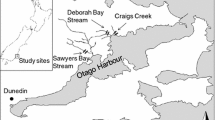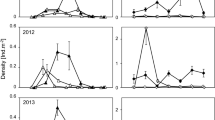Summary
We investigate a new continuous input ideal free distribution model which removes the assumption that resources are consumed as soon as they enter a patch. The model makes predictions about the standing crop of resources and allows consideration of the effects of simultaneous exploitation and interference competition. Using a group of cichlid fish competing for food items, we show that consistent with the model, standing crops can vary in continuous input situations. As predicted, higher standing crops are associated with increased intake rates. Furthermore, with greater numbers of competitors, standing crops are higher, suggesting that there is interference as well as exploitation competition in our system. An experiment to investigate the effects of fish density on the level of movement revealed that the reported interference competition could not be attributed to increased fish movement at higher density.
Similar content being viewed by others

References
Croy, M.I. and Hughes, R.N. (1991) Effects of food supply, hunger, danger and competition on choice of foraging location by the fifteen-spined stickleback,Spinachia spinachia L.Anim. Behav. 42 131–9.
Fretwell, S.D. and Lucas, H.J., Jr (1970) On territorial behaviour and other factors influencing habitat distribution in birds.Acta Biotheor. 19 16–36.
Godin, J.G.J. and Keenleyside, M.H.A. (1984) Foraging on a patchily distributed prey by a cichlid fish (Teleosti Cichlidae): a test of the IFD theory.Anim. Behav. 32 120–31.
Lessells, C.M. (1995) Putting resource dynamics into continuous input ideal free distribution models.Anim. Behav. 49 487–94.
Milinski, M. (1979) An evolutionarily stable feeding strategy in sticklebacks.Z. Tierpsychol. 51 36–40.
Milinski, M. (1984) Competitive resource sharing: an experimental test of a learning rule for evolutionarily stable strategies.Anim. Behav. 32, 233–42.
Milinski, M. and Parker, G.A. (1991) Competition for resources. InBehavioural ecology: an evolutionary approach, Vol. 3 (J.R. Krebs and N.B. Davies, eds), pp. 137–68. Blackwell Scientific Publications, Oxford.
Parker, G.A. (1970) The reproductive behaviour and the nature of sexual selection inScatophaga stercoraria L. II. The fertilization rate and the spatial and temporal relationships of each sex around the site of mating and oviposition.J. Anim. Ecol. 39 205–28.
Parker, G.A. (1982) Phenotype-limited evolutionary stable strategies. InCurrent Problems in Sociobiology (King's College Sociobiology Group eds) pp. 173–202. Cambridge University Press, Cambridge.
Sutherland, W.J., Townsend, C.R. and Patmore, J.M. (1988) A test of the ideal free distribution with unequal competitors.Behav. Ecol. Sociobiol. 23 51–3.
Tregenza, T. (1995a). Building on the ideal free distribution.Adv. Ecol. Res. 26, in press.
Tregenza, T. (1995b) On the ideal free distribution. PhD thesis, University of Liverpool.
van Duren, L.A. and Glass, C.W. (1992) Choosing where to feed: the influence of competition on feeding behaviour of cod,Gadus morhua L.J. Fish Biol. 41 463–71.
Author information
Authors and Affiliations
Rights and permissions
About this article
Cite this article
Tregenza, T., Shaw, J.J. & Thompson, D.J. An experimental investigation of a new ideal free distribution model. Evol Ecol 10, 45–49 (1996). https://doi.org/10.1007/BF01239345
Issue Date:
DOI: https://doi.org/10.1007/BF01239345



